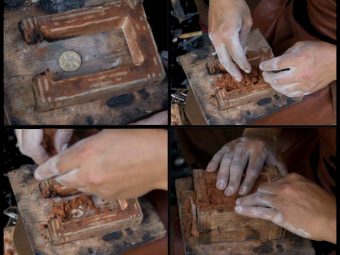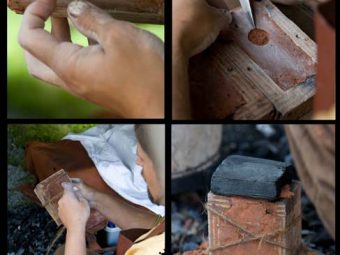Sand casting, a tecnique that started around 1300 AC and is widely used still today. Amongst other tings in the car industry or for ornamentation. This is what I generally recommend that you start with and also what I generally start teaching at my classes out of two reasons. 1 it is easier to make good molds when you are new and 2 if something goes wrong you can reuse your mold for another try and you can easily mass produce when required multipple copies.

 Then the original is removed carefully. A casting channel is carved in the sand. Making sure that the flask is properly secured and tight is important. Otherwise you tend to get floating metal which means more boring work afterwards. Left: Put your mold in one of the flask halves. Cover it with casting sand and pack it firmly. Then you turn the flask, attach the other half and repeat the procedure. Right
Then the original is removed carefully. A casting channel is carved in the sand. Making sure that the flask is properly secured and tight is important. Otherwise you tend to get floating metal which means more boring work afterwards. Left: Put your mold in one of the flask halves. Cover it with casting sand and pack it firmly. Then you turn the flask, attach the other half and repeat the procedure. Right
Left: The most exiting part! The casting itself. I make my own alloys, here I am casting a 90% copper 10% tin bronze. Right:When the metal has cooled down it is time to open the flask. If the casting is successful all that remains is the tedious polishing and in this case the setting of a gemstone.
I prefer to make tokens for the SCA during event. That way people can be part of making tokens for their friends by spending some time at the bellows and the items gets a bit more society history.